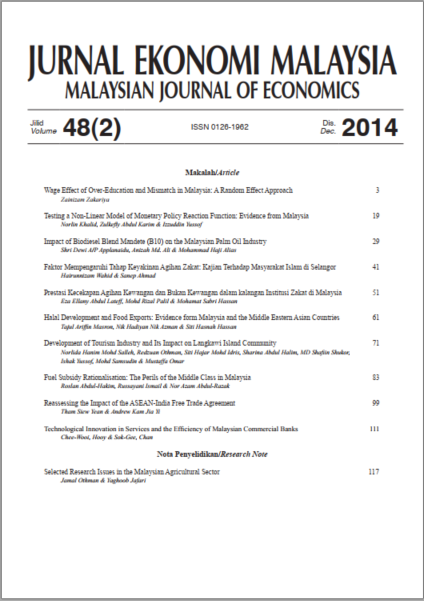Jurnal Ekonomi Malaysia
48 (2) 2014 83 – 97
Graduate School of Business
Universiti Utara Malaysia
06010 UUM Sintok, Kedah Darul Aman
MALAYSIA
Graduate School of Business
Universiti Utara Malaysia
06010 UUM Sintok, Kedah Darul Aman
MALAYSIA
School of Economics
Finance and Banking
Universiti Utara Malaysia
06010 UUM Sintok, Kedah Darul Aman
MALAYSIA
School of Economics
Finance and Banking
Universiti Utara Malaysia
06010 UUM Sintok, Kedah Darul Aman
MALAYSIA
Abstract
The middle-class is reported to experience the “middle-class squeeze”, where they are facing a declining relative income and simultaneously rising costs of living particularly with regards to housing, education and health care. Besides, the middle-class is also reported to face “the middle-class trap”, where on the one hand, they are regarded as “too rich” to qualify for any government support, but on the other hand, they found themselves in reality “not too rich” to sustain their lives without facing hardships. These observations unfortunately seem to be equally true in Malaysia, which raises the need to scrutinise the likely impact of government policy on the middle-class. With the recent fuel subsidy rationalisation in Malaysia, this paper attempts to analyse the likely welfare impact of this policy towards the middle-class in the Malaysian society. Examining this issue is crucial and desirable since the problems faced by the middle-class tend to be overlooked by the policy makers. In our analysis, we use various definitions of “middle-class” as suggested in the literature, and examine the direct, indirect and the total welfare effects of fuel subsidy removal on them using data from the Household Expenditure Survey (HES) 2004/2005 as well as the Input-Output Table for 2004/2005. Our findings reveal that, in line with the common perception, the benefits of fuel subsidy accrued mostly to the rich. Ironically, the costs of subsidy removal are borne mostly by the middle-class in terms of the direct welfare effect. Yet in terms of the indirect welfare effect, the costs of subsidy removal are borne equally by the middle-class as well as the lower and the upper class. Since the indirect welfare effect outweighs the direct welfare effect, we conclude that while the rich get most of the benefits from fuel subsidy, its removal hurts the middle-class the most. Our finding implies that fuel subsidy rationalisation must be followed by a practical strategy and program to lessen the negative impact of fuel subsidy removal not only for the poor, but also for the middle-class as well.
Keywords
Bibliography
@article{abdulhakim2014fuel,
title={Fuel Subsidy Rationalisation: The Perils of the Middle Class in Malaysia},
author={Hakim, Roslan and Abdullah, Othman Yeop and Ismail, Russayani binti and Abdul Razak, Nor Azam},
journal={Jurnal Ekonomi Malaysia},
volume={48},
number={2},
pages={83—97},
}
Receive updates when new articles are published.


